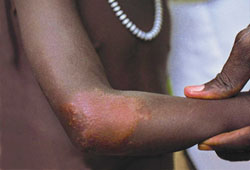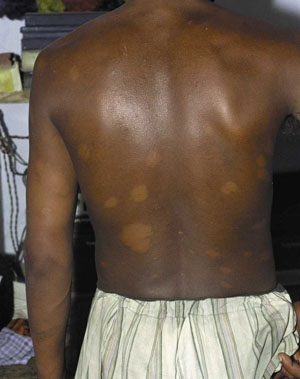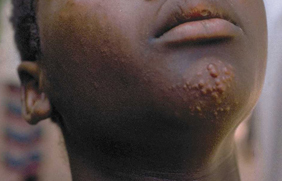History and exam
Key diagnostic factors
common
typical skin lesions
A variety may be seen, but macules, papules, or nodules are common. [Figure caption and citation for the preceding image starts]: Paucibacillary (PB) leprosy (borderline tuberculoid)WHO [Citation ends]. [Figure caption and citation for the preceding image starts]: Early multibacillary (MB) leprosyWHO [Citation ends].
[Figure caption and citation for the preceding image starts]: Early multibacillary (MB) leprosyWHO [Citation ends]. [Figure caption and citation for the preceding image starts]: Multibacillary (MB) leprosy nodulesWHO [Citation ends].
[Figure caption and citation for the preceding image starts]: Multibacillary (MB) leprosy nodulesWHO [Citation ends].
An early lesion may occur as an ill-defined, hypopigmented or erythematous patch with anesthesia. The lesions can be reddish or copper-colored. The disease can also occur with multiple infiltrated plaques or just diffuse skin infiltration.
nerve involvement
Examination should include palpation of peripheral nerves. There may be tenderness, paresthesias, or thickening of a nerve. Most commonly involved are the ulnar nerve, radial cutaneous nerve, median nerve, popliteal nerve, tibial nerve, and great auricular nerve. Also numbness of extremities and loss of nerve function (claw hands, foot drop, facial paralysis).
Leprosy can manifest itself as areas of anesthesia in the skin with no skin patches (pure neural leprosy).
sensory loss
A typical feature of leprosy. Skin lesions can show loss of sensation to pinprick and/or light touch.
Other diagnostic factors
common
immunologic reactions
Two types of reactions affect 30% to 50% of patients with leprosy: type 1 reaction (reversal reaction) and type 2 reaction (erythema nodosum leprosum). These reactions are often incorrectly viewed as complications of multidrug therapy. Reactions are medical emergencies that can increase leprosy-related morbidity. It is important to specifically recognize and treat reactions, to reduce the burden of disability in leprosy. A third, relatively rare, reaction is called Lucio phenomenon.
eye lesions
The eye may be affected by nerve damage to the muscles of the eyelid or to the cornea. Leprosy is the third leading cause of blindness worldwide. Leprosy patients can develop ocular complications, such as corneal ulceration, iridocyclitis, and lagophthalmos.
Risk factors
strong
close contact with a person with multibacillary leprosy
The actual incidence among contacts and the relative risk for them appear to vary considerably in different studies. Infection rates for contacts of people with lepromatous leprosy have varied from 6.2 per 1000 per year in Cebu province in the Philippines to 55.8 per 1000 per year in a part of South India.[21][22]
poverty
Leprosy is usually, but not exclusively, associated with deprived communities where poor nutrition, overcrowding, and poor standards of hygiene are most common.
residence in endemic area
In 2018, 96% of new cases of leprosy were reported in 23 global priority countries: Angola, Bangladesh, Brazil, Comoros, Côte d’Ivoire, Democratic Republic of the Congo, Egypt, Ethiopia, Micronesia (Federated States of), India, Indonesia, Kiribati, Madagascar, Mozambique, Myanmar, Nepal, Nigeria, Philippines, South Sudan, Sri Lanka, Sudan, Somalia, and United Republic of Tanzania.[23] The majority of these cases were in Brazil, India, and Indonesia.
weak
genetic predisposition
There is evidence that not all people who are infected with Mycobacterium leprae develop leprosy. Genetic factors are thought to be influential, based on the observation of clustering of leprosy around certain families.
zoonotic transmission
In the southern United States, patients with leprosy and no foreign exposure have been found to be infected with the same strain of Mycobacterium leprae as wild armadillos in the region.[14]M leprae and M lepromatosis have been found in red squirrels in the UK and Ireland and in wild chimpanzees in West Africa.[15][16]
Use of this content is subject to our disclaimer